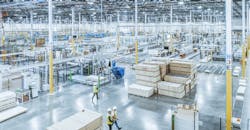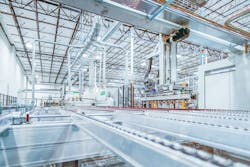Vaughan Buckley on Restarting a Former Katerra Factory
This is a longer version of an interview that appeared in the January 2022 issue of Pro Builder.
In a 2018 interview with Pro Builder, Vaughan Buckley, then president of his own construction company in Philadelphia, stated his intent to be at the forefront of what he envisioned as a vastly different construction market by 2030. Last August, the now-CEO of modular builder Volumetric Building Companies (VBC) completed a $25 million purchase of a 577,000-square-foot manufacturing plant in Tracy, Calif., formerly owned and run by Katerra, the recently failed poster child of that new age. The purchase not only expanded VBC’s reach into the West Coast but also made it a manufacturer and supplier of building components. Buckley talks with Pro Builder about restarting the plant, tapping into Katerra’s technology and people, and his new openness to horizontal integration.
PRO BUILDER: How many Katerra employees have been rehired?
Vaughan Buckley: We have about 50 employees in California [as of late November 2021], and a good portion of them are returning employees from Katerra’s operation. We’re really enjoying having the institutional knowledge, the experience, and the capability the Katerra employees bring to the table, but it’s also important for us to chart our own path and not rebuild what Katerra did. So there’s this balance of experience and respect for what’s being built today combined with the expectation of innovative technology and growth in the direction that we see it going forward.
PB: What about the Katerra culture do you undo or keep as these returning employees onboard with VBC?
VB: Katerra was a phenomenal organization and had very committed people from a cultural perspective. I think that if we want to make adjustments, it’s probably in the areas of the business model and the go-to-market strategy. We’re taking that approach with each of the [production] lines for cabinets, countertops, windows, floors, walls, ceilings, and trusses, and each of them really needs to be independently profitable.
Perhaps a better word for that is viable. For example, if we’re unable to fabricate countertops in a way that’s efficient and effective for us, then we should be buying countertops [from another source] instead of fabricating them ourselves. That’s not to suggest that our countertop production line isn’t viable, it’s just to illustrate that we have to evaluate everything on its face. Just because we can do it ourselves doesn’t mean we should.
PB: So the intention is to treat every production line as a separate profit center?
VB: Yes, each line will be a separate revenue center from the core business of making modules. And yes, we are expecting each of them to be able to perform independently. If they don’t, they should be replaced. We’re looking through the plant and the opportunities as we turn on the lines now. We have our cabinetry production line up and running. We have some trusses being built, and we’ll slowly turn on wall components and then, eventually, we’ll move to manufacturing modules as well. Right now we’re in cabinetry production mode and we started building kitchens in October. I think our first few hundred kitchens are built and have either been delivered or installed at this point.
PB: In that context, what do you mean when you say “kitchens,” specifically?
VB: I’m referring to the cabinets and components that go with kitchens. Right now, the production line that’s operational in the facility and that’s generating the most revenue and has the majority of our employees engaged is cabinetry production. We can produce about 8,000 cabinets per month on that production line in a single shift.
RELATED
- On-Site vs. Off-Site: a Total Cost Analysis for Home Builders
- 3 Reasons Off-Site Construction Could Help Shape the Future of Housing
- Housing, Industrialized: Your Road Map to Off-Site Construction
PB: Any idea when you are going to turn on production for modules?
VB: We were anticipating turning on production for modules in January of 2023. That has now moved forward and could start as early as April 2022. Typically, we build what we design, so that’s why we chose 2023 [for the modules], but we have had a lot more demand for production sooner than we expected. We wanted to give ourselves time to get stuff designed, titled, and ready to go, but we have a lot of folks coming to us that need modular projects built now and they’re asking us to either take over or to support them on the design and engineering front but to use their existing modular buildings, which were already designed and permitted from modular. So it's a bit different from trying to redesign a site-built building. And yeah, we could have modules running through and as soon as six months.
PB: So other modular home builders are approaching you to take on their capacity or to help them with their lack of capacity?
VB: Yes, modular builders, not modular factories. So folks that are constructing their buildings using modules are coming to us saying they need a factory, and we've had one or two factories reach out to us for shared capacity as well. The problem is that with most factories, when you're looking for shared capacity, you're looking for it today because you don't want to offer somebody your business in six months and then find you need it six months later. So I expect we will get some of that capacity sharing, but that's usually on a much shorter time schedule.
PB: Have any traditional stick-frame home builders approached you?
VB: Yes. The traditional home builders are more interested in seeing a panelized program out of the factory for their housing, which we're open to. And then there are also folks looking to us to redesign existing buildings they have designed and want to consider for modular construction. Obviously, we do both, so either way is good for us.
PB: You probably can’t reveal their identity, but are they small regional builders, big nationals ...?
VB: All of the above. We’re dealing with some of the largest home builders in the country and with local builders in the area.
PB: And I assume they are Bay Area, West Coast companies, just because of the logistics of transportation for orders?
VB: Pretty much everybody's in California. They stretch maybe as far as Seattle, but are all West Coast for sure.
PB: Before Katerra even existed and before you had the opportunity to buy the Tracy plant, were you even thinking about horizontal integration, and if not, did the supply chain woes from the past year make you more comfortable with doing so?
VB: I would have said no to horizontal integration as recently as two years ago. It just wasn't necessary. But once the pandemic hit, horizontal integration became almost a necessity for factories in order for them to be able to stabilize the supply chain. There was just so much volatility. Procuring materials in a timely fashion wasn't possible and maintaining cost controls was a challenge, so the idea of being able to build our own cabinetry in a few weeks versus waiting months is just huge.
We had one particular client we built for that signed a contract for cabinets with a competing factory in our area. They signed that contract in July and were supposed to get cabinets in September. Then it was October, then December. They came to us in mid-October when the last push occurred and they asked, can you help us? We had cabinets on the ground for them in two and a half weeks.
I think that with VBC's execution experience combined with our plan of innovation and growth over the next few years, we're going to have an opportunity to really catalyze some of the technology Katerra was working on.
This is the support level we can provide and I think that's the area where we're going to see the most movement. Right now I've been able to do that because we're still going through existing inventory. We have some colors in stock ready to go. But as we start to build out our inventory, we'll be able to offer three to six different colors with one- to two-week lead times on cabinetry because that's the kind of throughput we have in that factory. So that's kind of exciting.
PB: Do you think that post-pandemic the construction supply chain will see more horizontal integration?
VB: I don't think we're going to see a lot more of it in the site construction world. I still don't think it makes sense for them to do it, the reason being that the impact on site construction is just simply not as drastic. Now, that's not to say they don't have challenges. But think about appliances, for example. If a fridge doesn't show up to a jobsite this week and the appliance manufacturer pushes it back a month, well that jobsite doesn't have a fridge for a month, but everything else continues just the way it would and that fridge gets put in at the end and everything is fine. If that same fridge doesn't show up to a manufacturing facility where it's due to go into a module, and it doesn't show up for a month, that module may not even be in the same state. It may not be in the same region, and the appliance may not be able to be installed. So now you have issues of a fridge showing up at a manufacturing facility where the module it's supposed to be getting installed in isn't even there anymore.
We've had situations where we've had to chase appliances into modules five states away, and it's not even at the jobsite yet. So when you start trying to add up the cost of complexity of those challenges in a modular factory, and you start applying it to areas where you can actually have an impact, like say cabinetry or inventory of flooring, or just getting into some of those more finished goods so you never ever run out of them, the implication is so great that horizontal integration really makes a lot of sense. But I think that's primarily in a manufacturing environment. On a jobsite, I just don't see it happening.
PB: What is happening with former Katerra customers whose projects were left stranded by the bankruptcy?
VB: Most of the time they are reaching out to us and we've been able to support them with wrapping up their orders, getting additional products out to them where needed, or taking over where necessary. I will say that Katerra bought their work. A lot of the business they had was because their pricing was so attractive, and so there are a lot of jobs that simply aren't recoverable at the numbers Katerra bid them for. And the pandemic, with material shortages and price volatility, certainly didn't help.
There's a lot of technology Katerra created and patented that either wasn't commercialized or wasn't ready to be commercialized.
But pre-pandemic, some of the numbers signed with Katerra didn't make sense even before the material cost increases. So I think there are a decent number of projects and buildings that we're looking at that we're unable to help because, for example, maybe one project we were looking at had a $900,000 cabinetry order. That same order today would be $1.5 million and it probably should have been priced somewhere in between when it was first contracted. Those kinds of gaps we can't help fill. There has to be a reset in the market for expectations regarding pricing. We can do lead times and really short response times. We can help get things in at a high quality and almost always be at a lower cost than our competitors, but we're not buying the work.
PB: Did you donate work in progress?
VB: We have donated work in progress that existed, yes. Anything already in the building that was just half done for a client, we donated it, but we didn’t build the rest of their building for free.
PB: Besides a higher level of automation, more product diversity, and becoming a horizontally integrated supplier, what is VBC getting from acquiring the Katerra plant that it didn’t have before?
VB: There's a lot of technology Katerra created and patented that either wasn't commercialized or wasn't ready to be commercialized. I think that with VBC's execution experience combined with our plan of innovation and growth over the next few years, we're going to have an opportunity to really catalyze some of the technology Katerra was working on by implementing it into structures and buildings and design around the country. So I think what we've really achieved with Katerra is this incredible opportunity to catapult the growth of the implementation of the technology that Katerra had already begun working on. You combine their technology expertise with our execution expertise and our innovation mindset and I think we have an opportunity here to really push the industry forward.
PB: Can you give an example of an innovation that would be available once VBC commercializes it?
VB: We already do augmented reality and virtual reality training and tours within our projects. So a client walks through their building before they sign off on it. Our team leads on the floor walk-through of the building without the drywall installed virtually to make sure they understand what it's going to look like. That's our VBC tech. Katerra is building tech to tag individual families within the building system to create live [centralized bills of materials] that are adjustable throughout the project. Putting those two technologies together, we can now walk through a building and check inventory against parts virtually. We can tie into the integrated ERP [enterprise resource planning] systems and manage both our ordering inventory and purchasing right down the installation of the individual component into the building. You know, Katerra spent $20 to $30 million on building their ERP system and integrations, so it's really a big jump for us to be able to capitalize on that.
PB: So you'll be able to see supply-chain availability in real time rather than having to pull a report that might be old?
VB: That is what we will be doing by taking their tech analysis and putting it together, yes. It's not there today, but that's part of what we can push forward.



